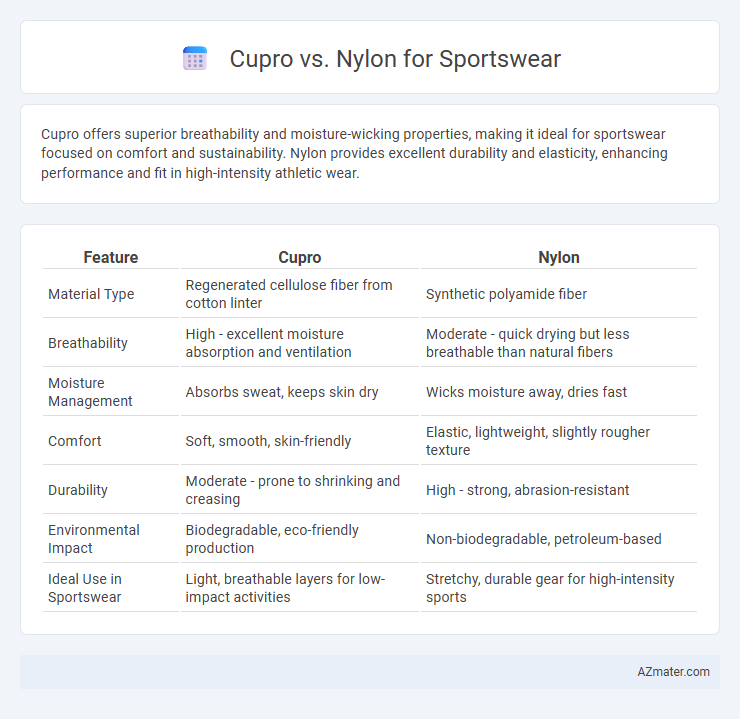Cupro offers superior breathability and moisture-wicking properties, making it ideal for sportswear focused on comfort and sustainability. Nylon provides excellent durability and elasticity, enhancing performance and fit in high-intensity athletic wear.
Table of Comparison
| Feature | Cupro | Nylon |
|---|---|---|
| Material Type | Regenerated cellulose fiber from cotton linter | Synthetic polyamide fiber |
| Breathability | High - excellent moisture absorption and ventilation | Moderate - quick drying but less breathable than natural fibers |
| Moisture Management | Absorbs sweat, keeps skin dry | Wicks moisture away, dries fast |
| Comfort | Soft, smooth, skin-friendly | Elastic, lightweight, slightly rougher texture |
| Durability | Moderate - prone to shrinking and creasing | High - strong, abrasion-resistant |
| Environmental Impact | Biodegradable, eco-friendly production | Non-biodegradable, petroleum-based |
| Ideal Use in Sportswear | Light, breathable layers for low-impact activities | Stretchy, durable gear for high-intensity sports |
Introduction to Cupro and Nylon
Cupro, a regenerated cellulose fabric derived from cotton linter, offers exceptional breathability and moisture-wicking properties, making it ideal for sportswear that requires comfort and temperature regulation. Nylon, a synthetic polymer known for its high durability, elasticity, and quick-drying capabilities, provides excellent strength and abrasion resistance suitable for intense physical activities. Both fabrics serve unique purposes in sportswear, with Cupro favoring natural comfort and Nylon excelling in performance durability.
Key Characteristics of Cupro
Cupro fabric is a breathable and moisture-wicking material derived from regenerated cellulose, offering excellent softness and a smooth texture ideal for sportswear. It exhibits high absorbency, helping to keep the skin dry by efficiently managing sweat during intense physical activities. Unlike nylon, Cupro is biodegradable and hypoallergenic, making it a sustainable and skin-friendly choice for athletes and activewear enthusiasts.
Key Characteristics of Nylon
Nylon is a synthetic fiber renowned for its exceptional strength, elasticity, and durability, making it ideal for sportswear that requires resistance to wear and tear. Its moisture-wicking properties efficiently draw sweat away from the skin, promoting breathability and quick drying during intense physical activities. Lightweight and abrasion-resistant, nylon enhances comfort and longevity in athletic apparel, outperforming natural fibers like cupro in resilience and maintenance.
Moisture-Wicking and Breathability
Cupro fabric excels in moisture-wicking and breathability due to its natural cellulose fibers derived from cotton linter, enabling superior sweat absorption and air circulation during intense sports activities. Nylon, a synthetic polymer, offers excellent durability and quick-drying properties but tends to trap heat and moisture, making it less breathable compared to Cupro. Athletes prioritizing enhanced ventilation and natural moisture management often prefer Cupro-based sportswear over nylon alternatives.
Comfort and Feel Against Skin
Cupro, a regenerated cellulose fiber derived from cotton linter, offers exceptional softness and breathability, making it highly comfortable for sportswear worn close to the skin. Nylon, a synthetic polymer, provides durability and moisture-wicking properties but can sometimes feel less breathable and less natural against sensitive skin. The smooth, silk-like texture of Cupro minimizes irritation and enhances comfort during prolonged physical activity compared to the often slicker, less absorbent feel of Nylon.
Durability and Performance
Cupro offers excellent breathability and moisture-wicking properties, making it ideal for active sportswear, but it tends to be less durable compared to nylon. Nylon excels in abrasion resistance, elasticity, and quick-drying capabilities, ensuring long-lasting performance and superior durability under intense physical activity. Sportswear made from nylon retains shape and strength better over time, while cupro provides a softer and more comfortable feel but requires more careful maintenance to prevent wear.
Sustainability and Environmental Impact
Cupro, a regenerated cellulose fiber made from cotton linter, offers superior biodegradability and a lower environmental footprint compared to nylon, which is a synthetic polymer derived from petroleum. The production of cupro involves fewer greenhouse gas emissions and reduced microplastic pollution, making it a more sustainable choice for sportswear. Nylon's durability and moisture-wicking properties are notable, but its reliance on fossil fuels and non-biodegradability pose significant challenges for environmental sustainability.
Care and Maintenance Requirements
Cupro sportswear demands gentle care, requiring hand washing or delicate machine cycles with mild detergents to preserve its soft texture and prevent fiber damage. Nylon, highly durable and moisture-wicking, withstands regular machine washing and dries quickly, making it low-maintenance and ideal for activewear. Proper care extends the lifespan of both fibers, with Cupro needing more cautious handling compared to the resilient and easy-care nature of Nylon.
Cost Comparison
Cupro fabric tends to be more expensive than nylon due to its production process derived from regenerated cellulose fibers, resulting in a luxurious feel and sustainability appeal. Nylon remains cost-effective for sportswear manufacturing because of its synthetic origin, durability, and widespread availability, making it a preferred choice for budget-conscious brands. When comparing cost efficiency, nylon offers greater affordability and scalability, while cupro commands a premium price reflecting its eco-friendly properties and comfort benefits.
Which Fabric is Best for Sportswear?
Cupro offers excellent breathability and moisture-wicking properties, making it ideal for sportswear that requires comfort and skin-friendliness. Nylon excels in durability, elasticity, and quick-drying capabilities, which are crucial for high-performance athletic activities and intense workouts. For sportswear, nylon is generally the best choice due to its superior strength, stretch, and resistance to abrasion and sweat.

Infographic: Cupro vs Nylon for Sportswear
 azmater.com
azmater.com